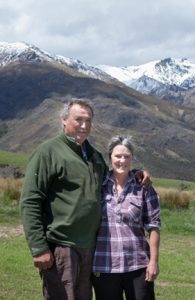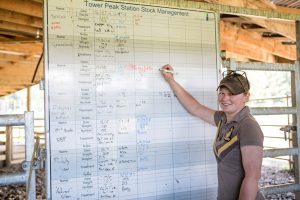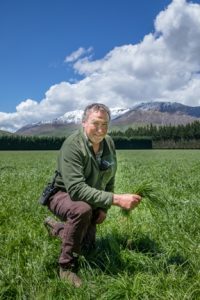Southland’s Takitimu mountains are home to a huge station raising young heifers for Canterbury equity partnerships. Anne Lee reports.
High up against the soaring, ragged Takitimu mountain range that sits as a gateway to Fiordland, is the last place you’d expect to find a vast, lush terrace that’s home to 3200 dairy heifers.
The huge, 1300-hectare, Tower Peak Station is full of surprises though – a place where everywhere you turn there’s another jaw-dropping view and around every corner is another expanse of verdant high-quality pasture, mobs of shiny coated heifers or paddocks of deep fertile, finely worked soil ready for their winter crops to be sown.
Bulls, beef cattle and even a mob of 100 sheep can be found enjoying the landscape.

The farm is owned by Canterbury dairy farming equity partnerships Canlac Holdings and Singletree Dairies and managed by shareholders in those two companies Russell and Leanne Clearwater.
The couple are award-winning dairy farmers and were the initial equity managers in Canlac.
They made the big move south 18-months ago when the partnership bought the farm although it’s had a history of ownership with some of the shareholders since 2008, originally through Spectrum Group.
Russell and Leanne have brought their passion for rearing great young stock and their expert knowledge in pasture management to the station.
Russell says Tower Peak’s core job is to rear close to 1500 young stock for the two Canterbury dairy businesses which milk a total of 5000 cows.
The balance of the 3200 rising-two-year-olds that winter on the farm are from other dairy farms, mostly from the Southland area.
All up 13 different entities send their calves to the property for the 15-16 months it takes for them to be grown through to being in-calf themselves and ready to go back to their herds for wintering prior to their first calving.
‘I look at it like a limited overs cricket match. If you leave your run too late then the run rate’s too high and you don’t make it.’
The property had been glanced but not hit with Mycoplasma bovis when it was suspected as a trace farm before Russell and Leanne came on board. It was fully tested though and certified clear but managing biosecurity and ensuring no animal-to-animal contact from heifers from different farms is now a strict part of the system.
Russell says the aim in buying Tower Peak was to help reduce grazing costs for the two farming entities in Canterbury which were paying about $1 million between them on grazing.
The farm had to be big enough to support a management team so that it could operate without the dairy farm staff.
Equivalent land in Canterbury was selling at close to $45,000/ha but by coming further south they were able to buy the large-scale enterprise for a fraction of the cost.
Russell says Tower Peak ticked all the boxes and by taking on additional grazing it’s a profitable business that more than pays its way and is able to reduce debt.
The programme
From late November the calves start arriving en masse.
Close to 20 unit loads of young animals will arrive over a two-month period and when trucking R2s out in April is included, more than 100 unit loads of animals a year come and go.
Each animal’s time on the station is electronically tracked and recorded with drenchings, weighings and matings all noted.
MINDA CSV data files can be sent before the calves arrive with the information loaded into the Tower Peak system.

They’re grouped on the system as belonging to their particular farm and remain in that electronic and physical group for the rest of their time on the station.
A giant etched whiteboard allows monthly key data and information to be recorded for each group too so that at a quick glance the farm team can see what actions should be taken at each monthly visit to the yards for the young animals and what happened last time.
Diligently recording data and information, both electronic and written is a big part of keeping the system running smoothly at Tower Peak.
Stock movements in and out of the station, deaths, animal health actions, just about everything that’s carried out with the stock is recorded when it happens and each month Leanne loads that up into the stock reconciliation spreadsheet.
Monthly invoices can then be produced and sent out to farmers.
When the calves arrive they’re unloaded and settled in for a day and then brought into the large covered yards and run through the Gallagher weigh system to have their weights, EID numbers and visual tags recorded.
All calves will have received a copper bullet and seven-in-one drench before they arrive on the station so they’re covered for leptospirosis and clostridia disease.
On that first weigh-in at Tower Peak they’re given a triple acting “quarantine drench” and then moved out to the paddock areas they’ve been allocated to.

a dairy farm without a dairy shed.
“We let them selectively graze rather than break-feed them for as long as we can while they’re calves. They’ll go into a paddock about half a round length before the R2s,” Russell says.
Tower Peak carries its own beef animals with about 235 R2 beef steers and heifers and they’ll be used to clean up behind R2 dairy heifers if needed.
The grazing system helps lower the worm burden for calves too.
Russell and Leanne set a minimum of 100kg before they’ll take delivery preferring they’re heavier than that the later the arrival date.
The aim with a weaned calf is to get a good quick transition out of weaning so they’re moving forward and growing.
Getting calves to good weights before their first winter is very much the focus and how well they’ve been reared as young calves early in their lives is important.
“There are four main stages in getting heifers to 90% of bodyweight before first calving and each stage can depend on the success of the one before it.
“I look at it like a limited overs cricket match. If you leave your run too late then the run rates too high and you don’t make it.
“If they arrive here late and light then we’re racing to get them to where they need to be,” Russell says.
The R1s are drenched every 28 days with a double-acting oral drench and in autumn are given a booster for leptospirosis.
Through autumn they’re likely to go on to a break-feeding regime with plenty of high-quality pasture so the station’s target average cover for the start of winter can be achieved.
The R1s are transitioned on to crop in mid-May and drenched with an injectable, Eclipse E, get a long-acting selenium injectable and get a 20g copper bullet.
They’re automatically weighed in the yard every time they’re drenched and their weights recorded through the Gallagher weigh system. The CSV file is then emailed through to LIC to load it on to MINDA Weights.
If the dairy farmers haven’t loaded their young stock in MINDA the information is sent via email.
From this coming winter the winter crop will include more fodder beet as the station aims to use the higher yielding beet to reduce the cropping and re-grassing area.
Leanne says they’ve re-grassed about 400ha since they arrived just because of the cropping programme using swedes. A good portion of the station’s 1100ha of flat terrace land had been re-grassed over the two to three years prior to their arrival too.
They grew 17-19 tonnes of swede crops last winter and expect fodder beet crops to also do well.
A portion of the area in winter crop this coming winter will be double-cropped – so go from fodder beet to swedes the following winter before it goes back into permanent pasture.
Each mob winters on their own crop area and enough pasture is saved adjacent to the crop any tail-end animals can be taken off crop and set-stocked on pasture from early July.
From late November to April the station has both R1s and R2s to manage with staff busy setting up breaks, shifting animals, bringing calves in for drenching and heifer mating.
Mating
The station has the facilities to artificially inseminate (AI) heifers and this past mating four farms chose to do so.
“We do ask farmers to take part ownership of the job because our staff have their own jobs to do too. Some come themselves and some send their staff to help,” Leanne says.
Again, planning is a must and the farmers will order the semen and set the plan as to the type of synchrony and mating programme they’ll use.
“We’ll graze the AI heifers a bit closer to the yards so it’s easier on everyone and we plan ahead so there’s no clash with dates and using the yards,” Russell says.
This mating two Canterbury farms both used a double progesterone (PG) programme which meant injecting heifers twice, 11 days apart and then inseminated to detected heats for five days.
Marker bulls were then put out and on day 16 they inseminated again for another week on detected heats to catch returns (animals that failed to get in calf to first insemination and returned to heat) and take some pressure off bulls.
Another farm used a CIDR programme followed by blanket inseminations.
They have a purpose-built race with lift-up side and can get a good efficient system running.
“One mating we had 450 heifers from one farm to do on one day and got through them in 4.5 hours,” she says.
By the end of April it’s time to start the next major logistical project – getting heifers back to their farms.
Russell says they’re all weighed as they leave and NAIT transfers done very simply via an app that synchs with the Gallagher system in the yards.
Having coped with a major drought in their first summer and with two winters under their belts the couple know the station has the ability to grow plenty of top-quality feed.
“We’re confident we can churn out 450-480kg heifers year-in year-out that are 95%+ in calf,” Russell says.
The couple’s focus now is executing their plans year-in year-out and developing the next generation of management to do the same.
She’s come to stay
Working as 2IC on an expansive young stock rearing property on the other side of the world isn’t where Kathryn Hutchings expected to find herself when she set out on a bit of an OE from the United Kingdom three years ago.
But the 27-year-old has fallen for the Kiwi farm life and is soaking up every bit of knowledge she can on managing pastures and developing her management skills.
Having earned a Diploma in Agriculture from Lackham College in 2011 in Wiltshire and then running her own business doing general farm work, contract lambing and relief milking for five farming clients in the UK she set off on six-month working holiday in New Zealand in 2015.
She initially worked for Will Grayling at Ashpouri – part of Singletree Dairies and in October 2015, and four months into her holiday job, was offered a position on the leased support block in Canterbury.
“So I rang my parents and told them I wasn’t coming home after all.”
She worked for will for two seasons but when she went down to Tower Peak to help load up 3500 R2 heifers heading back to their farm owners, she fell in love with the place.
Russell and Leanne had not long arrived too and needed a competent extra person to make up what’s now a three-staff team and help run the busy, logistically full-on, multi-mobbed, intensive yet extensive operation.
With her small team of beloved dogs and already ensconced as the Te Anau Young Farmers chair it seems fair to say Kathryn’s found her place.
The scale of farming here, the opportunities to learn and develop skills and to progress have blown her away.
“If I’d stayed at home I’d still be doing what I was three years ago.”
She’s completed Primary ITO levels three and four and is now working on level five.
Management is in her sights and Russell says it’s rewarding to see someone come along and grasp the opportunities so many young Kiwi’s fail to see.
Pasture management
“We treat this place like a dairy farm without a dairy shed.
“Instead of producing milk we’re growing liveweight and we’re using pasture – and crops in winter – to do that,” Russell says.
The biggest challenge is carrying enough stock through the winter to effectively manage the growth through the spring.
“We have a certain demand for silage grown here for use in winter and autumn but beyond that we have to manage the surpluses with stock. So just like a dairy farm we’re always looking at supply and demand, setting up for spring in autumn and then through the spring, how we manage the surplus,” Russell says.
The large area of flat terrace land means most of the farm can be mown so they take both balage and stack silage.
They don’t feed out in spring to reduce supplement wastage and pasture damage and reduce the workload.
The aim is for a pre-graze cover of 3200kg drymatter (DM)/ha and residuals depend on the class of stock with beef cattle used to clean up.
They have more than 100 electric reels and standards so they can manage the pasture intensively.
Mob sizes are 100-180 making it easier to eyeball all animals and easier to manage them when it’s wet.
“If needed we can tuck them into gullies to save the terrace paddocks and provide more shelter, Leanne says, although the station is well planted with about 50ha worth of mature shelter belts.
While there are a lot of animals on the station it’s sheer size means, at 3.2 heifers/ha, it’s not highly stocked.
“Through the spring we have an average demand of about 8kg DM/animal so about 24 -30kg DM/ha/day and it doesn’t take long – about late September, early October before we’re growing above that,” Russell says.
It’s not uncommon for the property’s expanse of young grass to hit growth rates of 80kg DM/ha/day.
Through the autumn they set a round length that’s based on a square metre allocation area per heifer with feed demand met by what’s available in the paddock plus silage.





